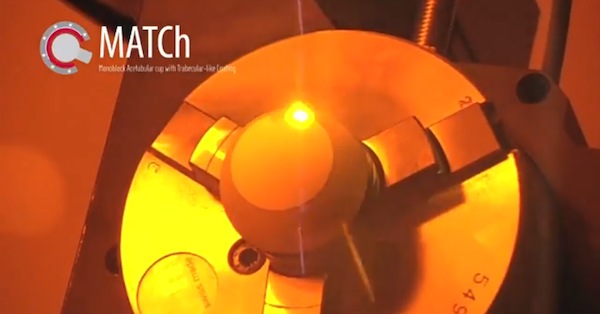
Monoblock Acetabular cup with Trabecular-like Coating (MATCh) is designed using glass and ceramics to improve hip implants. Credit: fundaciocim; YouTube
Hip joints are pretty darn important. The U.S. Centers for Disease Control estimates that more than 300,000 total hip replacements were performed in the U.S. alone in 2010, and total worldwide figures are estimated to be in the ballpark of 600,000 annually. That’s a lot of failing hips and a lot of new bionic ones, too.
Although much progress has been made on hip implant technologies, there is still room for improvement, though a new biocompatible glass ceramic implant technology may be able to help.
The implant project, called Monoblock Acetabular cup with Trabecular-like Coating (MATCh), is “designed to improve wear rate, allow a wider range of prostheses sizes and promote less trauma during surgical implantation,” according to the a press release from contributing partner Glass Technology Services.
Glass Technology Services principal technologist Martyn Marshall says in the press release, “Currently, replacement hip joints fit into cups which are housed in metal backs, which have a high risk of relative mobility, wear of the cup and potential damage to the pelvis.”
The MATCh project aimed to eliminate these limitations through incorporation of more biocompatible ceramic and glass materials to improve the interface between the implant’s acetabular cup and the patient’s pelvic bone, which would ultimately extend implant lifetime. The new cup is made of monolithic ceramic with a trabecular-like glass coating to promote integration with bone.
“The Monoblock ceramic cup anchors to the bone through a bioactive trabecular coating, glazed on all its surfaces,” Marshall says. “Ceramic-on-ceramic coupling has very low wear rate, gives a greater choice of prostheses sizes and involves less trauma in surgery. MATCh aims to develop prototypes which can accelerate osteointegration and avoid aseptic loosening due to wear, relative mobility and bone damage. This will radically improve the efficiency and longevity of hip joint operations.”
According to the MATCh website, “This unique coating is made of bioactive glass or glass-ceramic with trabecular-like morphology and high osteoinductive properties and so it is able to stimulate osteoblast cells to differentiate and deposit new bone within the implant 3D porous surface. This coating is deposited by glazing and is directly sintered on the ceramic cup, which is actually implanted for long-lasting couplings (alumina or alumina/zirconia composites) in a modular geometry.”
The cup is designed and fabricated in three layers: an alumina-zirconia cup made by subtractive manufacturing, a glass (SiO2-CaO-Na2O-P2O5-B2O3) interlayer manufactured by dipping, and a trabecular coating made by sponge replication. Watch the video above and head over to MATCh’s website to see some great images of the whole process and learn more about the project.
The website and press release don’t provide any information on whether tests have yet been performed to see how well cells can migrate and integrate with the trabecular-like coating or whether clinical trials are planned for the future.
The work, a collaboration between Glass Technology Services Ltd, FAME-MED, and EXEMPLAR, in partnership with Innovation Centre Iceland (ICI) Politecnico di Torino, Asociacion de investigation metalurgica del noroeste (AIMEN), and Centre CIM Fundacio Privada (FCIM), was funded by a grant from the European Union’s Seventh Framework Programme.
